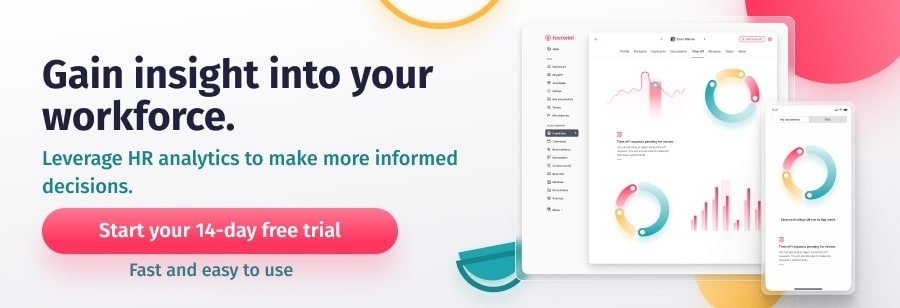Turnover is one of the key HR metrics. Leverage the data about involuntary termination rate to help identify areas for growth.
Nothing lasts forever. At some point or another, an employee will leave the company for good.
However, the hows and whys of the termination of employment can vary widely.
In most cases, a member of staff will leave the post of their own volition. This could happen because they’re relocating to another part of the country, retiring, or they’re simply pursuing a new challenge at a different company.
Resigning from a post is called voluntary termination. But there’s also involuntary termination, which is essentially a technical term for saying the employee was forced out of the company. The involuntary termination rate is one of the key metrics your HR department should be taking into consideration.
A high rate can reveal problems with your business’s hiring and onboarding practices. It can also show issues with your company culture or managerial practices.
In this blog, we’ll run through the ins and outs of this second type of termination. We’ll look at what involuntary termination looks like, how to reduce it, and how to offboard the terminated employee.
- What is involuntary termination?
- How to calculate the turnover rate
- How to reduce your involuntary termination rate
- Offboarding Best Practices
What is Involuntary Termination?
Involuntary termination is when a company removes an employee from their post and thus ends the employment relationship. This can happen due to poor performance, unprofessional behavior, or a strategic shift within the company. It differs from voluntary termination and mutual termination in that the employee has no say in the decision.
There are two types of involuntary termination — with cause and without cause.
With Cause
“With Cause” termination is when a company fires an employee for a reason. These reasons include poor performance, a violation of company policy, repeated lateness, or violence/aggressive behavior in the workplace.
In most cases, the company will have warned the employee that they face dismissal if they do not change their performance/behavior.
In many instances, businesses may have offered a performance improvement plan to struggling employees.
However, there are instances when a company will fire an employee without prior warning.
For example, if an employee threatens others in the workplace or otherwise grossly violates company policy.
Without Cause
Involuntary termination doesn’t always mean that the employee has done something wrong.
In some cases, a company will remove an employee from their post through no fault of the employee. This is “without cause.”
For instance, if a company runs into financial difficulties or downsizes and has to lay-off staff. This type of termination relates to a company’s business objectives or wider economic conditions.
How to calculate the turnover rate
Involuntary termination is more than an incidental employment factor. It’s in the company’s best interests to keep the turnover rate low, both for voluntary and involuntary termination.
As such, HR should measure the employee turnover rate as a key performance indicator (KPI).
If it’s too high, there could be an issue with employee engagement, management performance, or the broader company culture. A high employee attrition rate can result in lost productivity and increased employee costs.
There are ways to improve the involuntary termination rate, but first, HR needs to know the rate. So how do you do that?
It’s a simple enough formula, providing you have the data you need (and a calculator).
You’ll need to know how many involuntary terminations occurred within a set period (of your choosing: the past month, six months, or year are most common). You can find this number by going through the termination documents in your company’s document management software.
You’ll also need to know the average number of employees within the same time frame (past month, six months, year). Do this by adding the number of employees at the beginning of the period to the number of employees at the end of the period, then divide by two.

For example:
The formula for calculating the turnover rate is as follows:
To learn the turnover rate for all employees, simply include all staff members that left (voluntary and involuntary).
How to Reduce Involuntary Termination Rate
There’ll be times when a company has no other choice than to let an employee go.
However, if a company has a higher-than-average involuntary termination rate, it’s important to take action. Firing and hiring employees can be highly capital-intensive and result in lost productivity and decreased workplace morale, among other consequences
So let’s take a look at some helpful tips that’ll keep the turnover percentage to a minimum. Note that these tips only refer to “with cause” terminations, not “without cause” terminations (since those are strategic).
Hire Correctly
An employee will be more likely to be fired if they were never a good fit in the first place. This isn’t just about their professional capacity to do their task well, though that is important. They should also be in sync with the company’s broader company culture. If they’re not, it’s more likely that problems will arise.
Reference checking during the hiring process can also highlight any potential causes for concern.

Successful Onboarding
Start as you mean to go on, is what they say.
If a recruit gets off on the right foot, then they’ll be more likely to succeed in the role.
In the case they don’t, then there’ll be a mountain to climb. And mountains are hard to climb.
A successful onboarding process will make the employee feel welcome and ensure they can hit the ground running.
Ongoing Training
Think of hiring the right recruit as planting a seed. The training you provide is the water that nourishes that seed.
An unwatered seed will go nowhere. An employee will be more likely to perform well if they’ve got the tools and guidance to deliver their best work.
70% of employees feel they haven’t mastered the skills they need for their positions.
Help employees to feel that they’re learning in their position, and they’ll be better able to contribute to the workplace.
Clear Expectations
It’s unreasonable to think an employee will follow a company’s guidelines if they don’t know what they are.
Your company policy functions to outline appropriate, inappropriate, and unacceptable behavior. This policy should be readily accessible to employees within their employee portal.
HR should communicate professional expectations on an individual employee basis via performance appraisals and the employee’s development plan.
Offboarding Best Practices
It’s a good idea to offboard all employees that leave the company. But it’s extra important when an employee is removed from their post since there’s a greater chance of legal blowbacks.
You’ll likely already have your own offboarding process at your business. If you don’t, then download our free offboarding checklist.
When dealing with an involuntarily terminated employee, some aspects of offboarding become more critical.
For instance, HR should ensure they have all documentation related to the terminated employee readily available in a document management platform. Revoking access to the company’s platforms and databases is also key.
Finally, unless the reason for the dismissal is serious, a farewell is appropriate. This relationship may not have worked out, but what’s done is done. Bid each other well, and move on.

Conclusion
Involuntary termination isn’t the most rewarding aspect of HR. It can be unpleasant at the best of times, outright ugly at the worst of times. Still, it’s an unavoidable part of running a business.
While HR teams can’t prevent it entirely, they can use it as a learning opportunity.
By diving deep into the data, HR can improve the hiring process, identify employee engagement issues, and ultimately learn from past mistakes.


